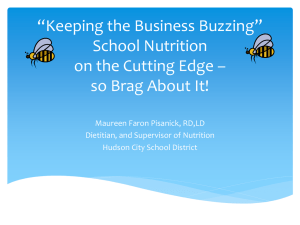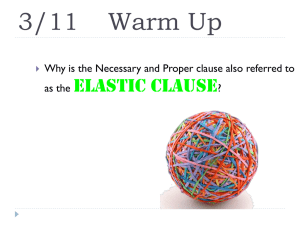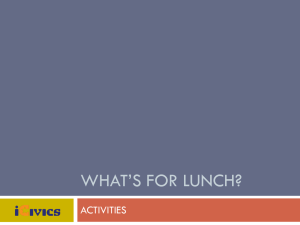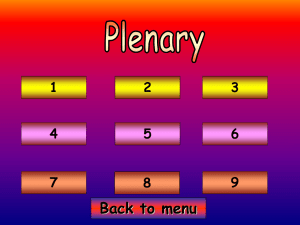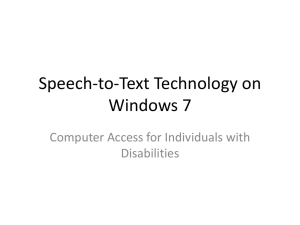US makes a law
advertisement
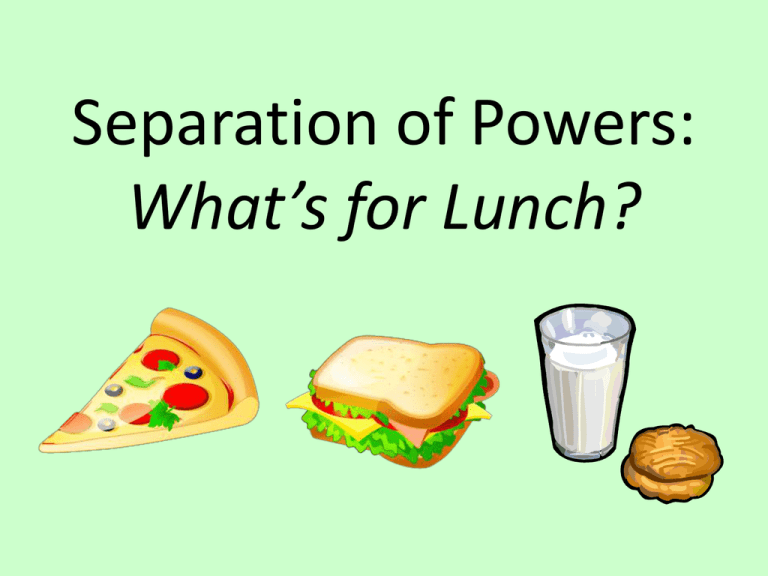
Separation of Powers: What’s for Lunch? How would you rate your school’s lunches? How would you rate the food in your school cafeteria overall? Do you think the food needs to be improved? Is the food being served healthy? 1= Horrible 2= Average 3= Delicious! 4= I don’t eat the food in the cafeteria. 1= Yes! 2= Some of it. 3= No! 4= No opinion. 1= Not at all 2= Sometimes 3= Always 4= What does healthy mean? Designing a New Menu: • Today, you and your classmates are in charge of designing a new menu for your school lunches! • One catch - it must be healthy!!! • Second catch – no single student can decide this on his or her own. This will be a group effort! Round 1: Choosing the Categories • Role = Lead Chef • Examine the menu options. • Debate amongst yourselves, and then CIRCLE the 5 categories for your menu upon which you can all agree. • Remember, it must be healthy! STOP WHEN YOU’RE DONE! Round 2: Creating the Menu • Role: The Writers • Using the categories that the “Lead Chef” developed, you are to choose what foods to serve. • Tip: Your menu must match the categories that the writers created. STOP WHEN YOU’RE DONE! Round 3: Move Forward or Try Again? • Role = Lead Chef • If you agree with what the WRITERS came up with, vote YES for the menu to be made. • If you do not like what the WRITERS decided, vote NO. This is a VETO! STOP WHEN YOU’RE DONE! Round 4: Where to go now? • If the Lead Chef said YES, your menu is one step closer to being made! • If the Lead Chef said NO, then the WRITERS must vote again on the menu. • If everyone likes the menu you created, it moves ahead. • If everyone does not agree, you would try again to write something the Lead Chef would agree with. However, there is not time for this today. STOP WHEN YOU’RE DONE! Round 5: Evaluating the Results • Role: The Judge • You have 2 important responsibilities: (1)Decide what “healthy” means. (2)Decide if the school lunch menu meets your definition of healthy. STOP WHEN YOU’RE DONE! Final Result: Will your lunch be made? • Raise your hand if your lunch will be made? • Raise your hand if your lunch will NOT be made? Quick Review: What was the goal? To make a healthy school lunch! • Round 1: The Lead Chef chose the categories. • Round 2: The Writers decided on the menu. • Round 3: The Lead Chef said yes or no to the menu. • Round 4: The Writers’ menu was approved by voting to overrule the Chef (if needed). • Round 5: The Judges evaluated whether the menu was healthy. • Final Result: Either the lunch will be made or it will not! If not, this all starts over from the beginning! In order for this to happen, what had to occur? • Each group had to perform its role. • Each group had to follow the rules. • The final product was a compromise of all three groups. Connecting School Lunches to Your Government: • The Lead Chef = Executive Branch • The Writers = Legislative Branch • The Judge = Judicial Branch • Your goal = Making School Lunches • The 3 Branches’ Goal = Making Laws Role 1: The Executive Branch • Main Part: The President • President’s job – There are several! – Set important issues for Congress to work on – Signs bills into law – Or says no, which is called a VETO – Is the boss of the government and makes sure the government carries out all the laws • Who does the President care about? ALL Americans Role 2: The Legislative Branch • Main Part: Congress • Includes: • The House of Representatives • The Senate • Job: Write and pass bills • Who do they care about? Their voters Role 3: The Judicial Branch • Main Part: The Supreme • Their job: To make sure Court the other two branches are playing by the rules! • What do they represent? The Constitution, which is the official rulebook for the U.S. government. Checks & Balances • First, because there are three branches in the law-making process, there is a “Separation of Powers” where no branch has more power than another. • To make sure that no branch is more powerful, the rounds that the branches go through to pass a law is known as “Checks & Balances.” This is where each branch “checks” one another to agree with the decisions each have made about passing a law. Let’s Review the Law-Making Process • What’s the goal? To make laws! • What must happen? – Round 1: President sets ideas for bills. – Round 2: Congress writes and passes bills. – Round 3: President says yes or no (VETO) – Round 4: If yes, bill is a law. If no, Congress votes again and tries to override the President. – Round 5: Supreme Court evaluates whether the law meets the rules of the Constitution. – Final Product: A Law or nothing! If a law … then the lunches will be made! Bonus Question: Which branch would make the lunch (i.e. carry out the law)? Today I Learned: •What are the 3 branches of the government, and what is each branch’s main job? •What is the goal the 3 branches are trying to reach? •Can any one branch reach the goal on its own? Why/why not? •Does any one branch have all the power? What is this called?
